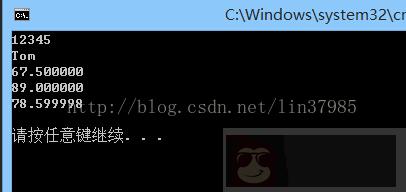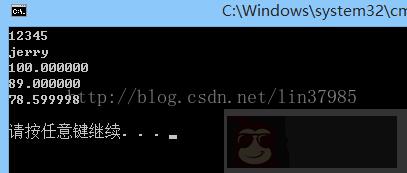共计 1385 个字符,预计需要花费 4 分钟才能阅读完成。
| 导读 | 结构体做函数参数有三种传递方式: 一是传递结构体变量,这是值传递,二是传递结构体指针,这是地址传递,三是传递结构体成员,当然这也分为值传递和地址传递。 |

以传引用调用方式传递结构比用传值方式传递结构效率高。以传值方式传递结构需要对整个结构做一份拷贝。
下面看一个列子,student 结构体中包含该学生的各种信息,我们在 change 函数中对其进行部分修改,再在主函数中输出其结果
下面传递结构体变量
| struct student | |
| { | |
| int num; | |
| char name[20]; | |
| float score[3]; | |
| }; | |
| void change(struct student stu); | |
| int main() | |
| { | |
| struct student stu; | |
| stu.num = 12345; | |
| strcpy(stu.name, "Tom"); | |
| stu.score[0] = 67.5; | |
| stu.score[1] = 89; | |
| stu.score[2] = 78.6; | |
| change(stu); | |
| printf(format, stu.num, stu.name, stu.score[0], stu.score[1],stu.score[2]); | |
| printf("\n"); | |
| return 0; | |
| } | |
| void change(struct student stu) | |
| {stu.score[0] = 100; | |
| strcpy(stu.name, "jerry"); | |
| } |

可以看到最终输出的值并未改变。。。
地址传递
| struct student | |
| { | |
| int num; | |
| char name[20]; | |
| float score[3]; | |
| }; | |
| void change(struct student* stu); | |
| int main() | |
| { | |
| struct student stu; | |
| stu.num = 12345; | |
| strcpy(stu.name, "Tom"); | |
| stu.score[0] = 67.5; | |
| stu.score[1] = 89; | |
| stu.score[2] = 78.6; | |
| change(&stu); | |
| printf(format, stu.num, stu.name, stu.score[0], stu.score[1],stu.score[2]); | |
| printf("\n"); | |
| return 0; | |
| } | |
| void change(struct student* p) | |
| {p->score[0] = 100; | |
| strcpy(p->name, "jerry"); | |
| } |

可以看到,通过地址传递修改了结构体内的数据
用 &stu 做实参,&stu 是结构体变量 stu 的地址。在调用函数时将该地址传送给形参 p(p 是指针变量)。这样 p 就指向 stu。
在 change 函数中改变结构体内成员的值,在主函数中就输出了改变后的值
结构体成员的地址传递和值传递
这个类似于单一变量的传递,这里也没必要说了,当然是地址传递才能修改。
把一个完整的结构体变量作为参数传递, 要将全部成员值一个一个传递, 费时间又费空间, 开销大。如果结构体类型中的成员很多,或有一些成员是数组,则程序运行效率会大大降低。在这种情况下,用指针做函数参数比较好,能提高运行效率。
正文完
星哥玩云-微信公众号
















